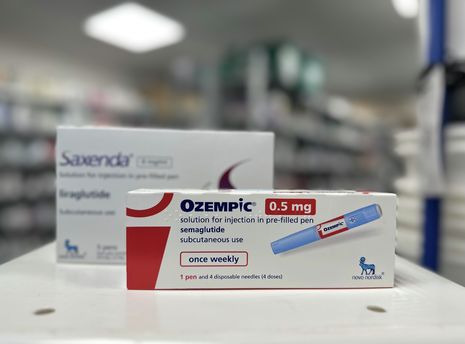Panacea or pharmastate nightmare?
Elizabeth Zachariah examines how the blockbluster success of Ozempic is shaping the global pharmaceutical landscape

Once prescribed to patients struggling to control their type 2 diabetes, semaglutide, better known by its brand name Ozempic, has become the new drug of choice for weight loss. As research emerges supporting the use of semaglutide to treat a huge variety of conditions, its popularity has continued to grow: 1 in 8 Americans were reported to have taken medication within the same drug class as Ozempic in a poll conducted by the Kaiser Family Foundation. Profits made by semaglutide for the manufacturer, Novo Nordisk, have led to the pharmaceutical company’s share price rocketing, shaping the global landscape of Big Pharma.
How does Ozempic work?
Following a meal, the hormone GLP-1 (glucagon-like peptide 1) is released from the intestine. GLP-1 has numerous effects on the body, the most significant being the promotion of insulin release and feelings of satiety. Semaglutide mimics GLP-1 to bind to the same receptor within the body, acting to boost the body’s existing system of insulin release and monitoring of fullness following a meal. This means that semaglutide can be used to improve blood sugar control in adults with type 2 diabetes, who fail to match insulin release to their blood sugar levels. Furthermore, a higher-dose formulation of Ozempic can be utilised in conjunction with diet and exercise to aid long-term weight management in adults who are obese.
A drug to treat many diseases?
Last March, the FDA (Food and Drug Administration of America) approved a new use for semaglutide: to ‘reduce the risk of cardiovascular death, heart attack and stroke in adults with cardiovascular disease and … obesity.’ Novo Nordisk has taken a ‘dual brand’ approach to selling semaglutide: the semaglutide preparation administered to patients to prevent cardiovascular disease is named Wegovy rather than Ozempic, and is available in a wider range of dosages. In the USA, the monthly cost of Ozempic is approximately $969, whilst Wegovy costs approximately $1,349 per month. This disparity in cost allows Novo Nordisk to decouple the price per unit of semaglutide from its different uses, allowing the company to align their profits from the drug to the differing market values of treating diabetes versus cardiovascular disease.
“Ozempic could potentially be used in ‘the treatment and prevention of cognitive decline and substance misuse’”
Further uses for semaglutide are likely to be approved in the near future, as recent research suggests additional possible indications for the medication. Researchers at the University of Oxford’s Department of Psychiatry published a study suggesting that semaglutide could potentially be used in ‘the treatment and prevention of cognitive decline and substance misuse’. Furthermore, multiple studies have found a correlation between use of GLP-1 analogues and a reduced risk of obesity-linked cancer. Novo Nordisk’s confidence in semaglutide’s panacea-like properties is clear, as the pharmaceutical company is currently managing two clinical trials (EVOKE and EVOKE+) in tandem to investigate if semaglutide has a ‘positive effect on early Alzheimer’s disease’.
The risk of a ‘pharmastate’ and increasing international tensions
Novo Nordisk is now the most valuable corporation in the European Union and is responsible for much of the recent economic growth in Denmark, in a manner reminiscent of weak ‘petrostate’ economies, which rely on oil as a primary source of income, making their economies vulnerable to fluctuations in oil prices. The unbalanced economic growth in Denmark due to semaglutide sales could threaten to take Denmark down the same path as Finland during the 2000s, when Nokia’s tumbling market share led to economic hardship within the country.
“Senators at the hearing repeatedly questioned why Novo Nordisk charges Americans with type 2 diabetes $969 a month for Ozempic, while the same drug is sold for $59 in Germany”
Beyond its economic impact domestically, semaglutide’s sale price has been stirring tensions between the US government and international Big Pharma. Last month, a Senate hearing was conducted to examine the pricing of Ozempic and Wegovy. Senators at the hearing repeatedly questioned why Novo Nordisk charges Americans with type 2 diabetes $969 a month for Ozempic, while the same drug is sold for $59 in Germany, with senator Bernie Sanders lambasting the company as treating the US as its “cash cow”. Novo Nordisk chief executive, Lars Fruergaard Jørgensen, evaded any commitment to lowering prices within the US, whilst frequently stating that he was “in support of” helping patients better access medications. This hearing perhaps indicates future post-election tensions between the US government and Big Pharma, with both presidential candidates Harris and Trump having previously expressed their keenness to slash drug prices.
Within the UK, semaglutide and other weight loss drugs may have the potential to offer policymakers a quick fix to the burgeoning burden of obesity related disease. ING healthcare analyst Diederik Stadig suggests the healthcare cost of obesity per person every year is £1400, whilst a year’s supply of Ozempic prescribed for weight loss costs £830 in the UK. Furthermore, Diederik argues healthcare expenses represent only a minority of the societal cost associated with obesity, suggesting obesity is a drain on economic productivity. Coupled with the likelihood that the cost of weight loss drugs will fall in the near future, there is a compelling argument for their use to solve the so-called ‘obesity epidemic’. The weight loss drug market is likely to become increasingly saturated, with one report suggesting there are 16 promising drugs in the pipeline for 2029. The report suggests the estimated market for obesity treatments could expand to $200 billion by 2031. Ozempic has paved the way for a legion of upcoming weight loss drugs that have the potential to define Big Pharma over the next decade.
 News / Cambridge academics stand out in King’s 2026 Honours List2 January 2026
News / Cambridge academics stand out in King’s 2026 Honours List2 January 2026 Interviews / You don’t need to peak at Cambridge, says Robin Harding31 December 2025
Interviews / You don’t need to peak at Cambridge, says Robin Harding31 December 2025 Comment / What happened to men at Cambridge?31 December 2025
Comment / What happened to men at Cambridge?31 December 2025 News / Varsity’s biggest stories of 202531 December 2025
News / Varsity’s biggest stories of 202531 December 2025 Features / “It’s a momentary expression of rage”: reforming democracy from Cambridge4 January 2026
Features / “It’s a momentary expression of rage”: reforming democracy from Cambridge4 January 2026










